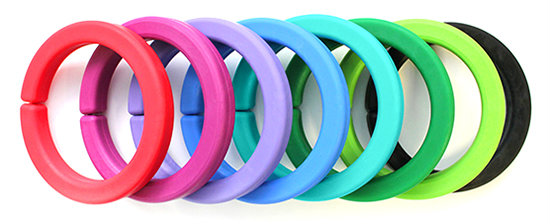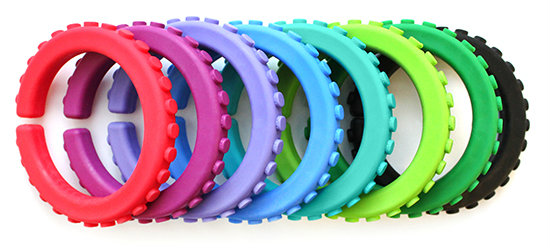10 Tips for Kids Who Need to Chew - An Oral Sensory Diet
Posted by Debra C. Lowsky, MS, CCC-SLP on 11th Apr 2016
Have you ever craved crunchy foods? Or chewed gum? Ever chewed on your pen caps while concentrating or bit your fingernails when nervous? We all have oral sensory habits to some extent.
For children with sensory needs and/or Autism, however, oral sensory input can play a particularly important role. Chewing throughout the day (especially during times of stress and/or anxiety) can help them calm, focus, and self-regulate.
There are several things you can do to help meet that need safely. For the purposes of this post I'll refer to children, but the recommendations here can apply for any age. Some kids grow out of it, others may always have oral sensory needs to some extent through adulthood.
Please note that the information here is based on my experience with the children I have personally seen as a speech therapist, and may not be relevant for everyone. There is NO substitute for an in-person evaluation with a trained professional, with treatment catered to your child's needs.
.
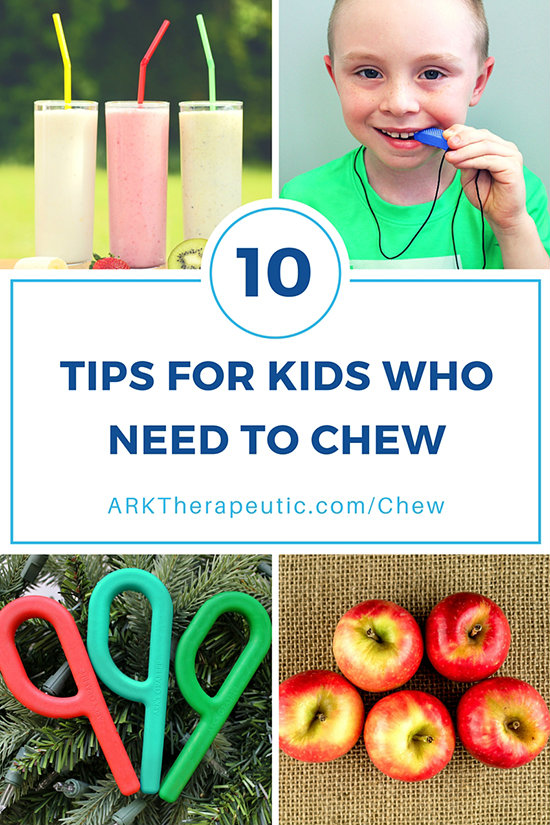
.
.
1. DON'T FORCE THEM TO STOP
It’s not that they WANT to chew. It’s that they have an oral sensory NEED to chew. Telling them to stop is not going to help.
Imagine being in a stressful situation and in order to calm down, you start taking very deep breaths. Then someone comes up to you and tells you to stop breathing deeply. That would be inappropriate, right? Why shouldn’t you try to calm yourself? Similarly, chewing is largely a coping mechanism - it’s a repetitive movement that helps one organize and de-stress.
We’ve heard some people say: “Letting your child chew on things is bad parenting - just tell your kids to stop.” This isn't true and won't solve the problem. It's possible that it might be behavioral. In my experience, however, regularly chewing on non-food items is usually sensory-based. Their bodies are telling them that they need proprioceptive input, and they’re astutely listening and following suit.
Not to worry, there are things you can try to decrease the chewing, which we'll cover below. But you should not force them to stop, especially not without helping them find other coping mechanisms and therapeutic interventions first. And they may always need to chew to some extent, which is ok. Work with it instead of against it.
.
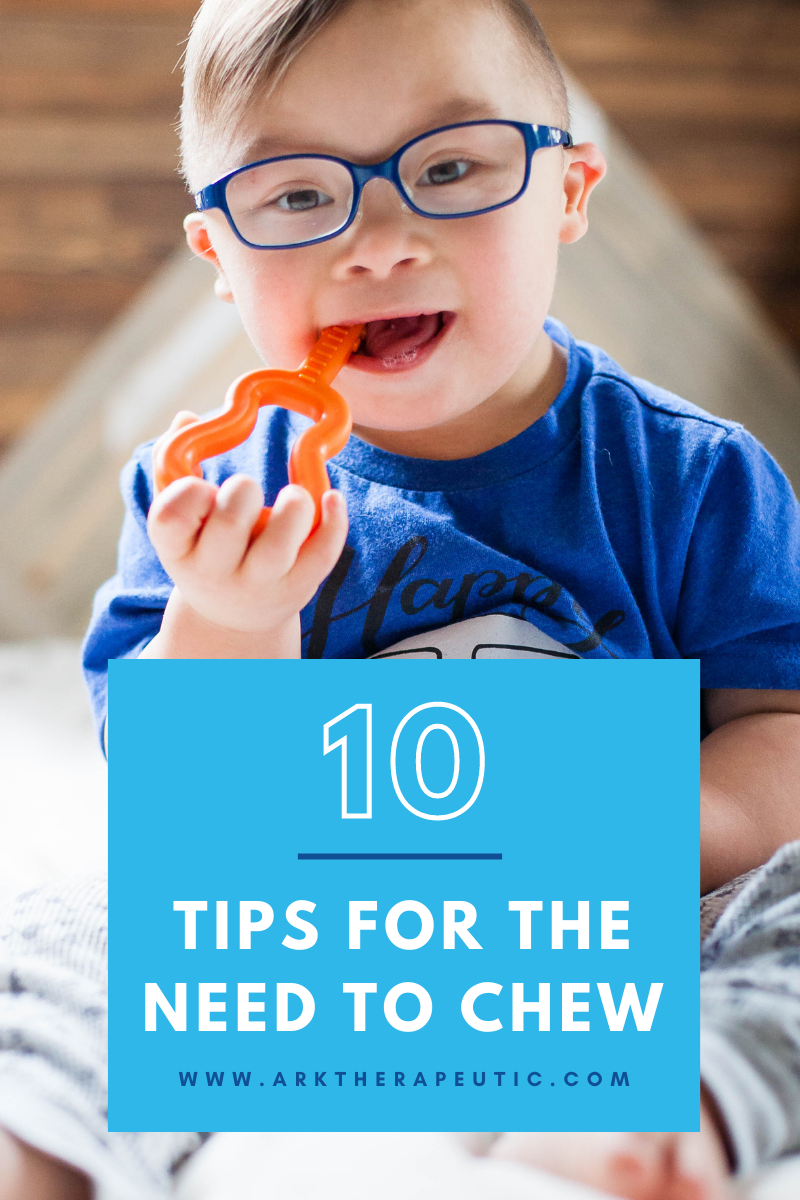
2. GIVE THEM A SAFE OUTLET TO CHEW ON
Children will often reach for the closest thing available to chew on, which may be their fingernails, knuckles, shirt collars, sleeves, pencils, the remote control, etc. Not only can it get expensive to keep replacing what's been chewed on, but more importantly, it can also be very dangerous. Some children will chew their knuckles down to the bone, chew their fingernails off, chew on something with harmful chemicals in it, etc. So first things first, give them a safe alternative to chew on instead.
The Grabber and Y-Chew were specifically created for this purpose and are still some of our most popular chew tools. We also make several "chewelry" options for more discreet on-the-go chewing. They all look like regular jewelry but with a cool secret: they happen to be chewable. To learn more about each design, click on the images below.
.
.
There are 35+ different chew options, but the above ones especially all have a long extension that can reach the back molars - this is where chewing is typically needed the most (and where it provides the most proprioceptive input to the jaw).. Some kids don't like having anything around their necks, in which case chewable pencil toppers (the last row of images above) and/or bracelets (below) are a good fit.
.
.
For help deciding which chew tool(s) to go with, use this guide to narrow down the options or shoot us an email here with the child's age and some background on their chewing habits and preferences.
Each time the child tries to chew on something inappropriate, remind him/her to chew on the chew tool instead. Be consistent and patient, as it may take some time to redirect the habit. For the best results, make it a team effort and get everyone involved in redirecting - teachers, parents, siblings, grandparents, babysitters, etc., at least until it “sticks.”
Like most things, oral sensory needs can vary greatly. Some children have a very mild need to chew, others have a very intense need to chew, and there’s everything in between. Some like to chew on things that are very soft and chewy, others have heavier oral sensory needs and need something tougher that will be longer lasting. All ARK chew tools come in 3 color-coded toughness levels to cover all the bases.
Sometimes a chew tool alone does the trick - the child may just need to have “chew breaks” here and there and use their “chewies” as needed.
However, oftentimes a chew tool is just one piece of the puzzle - other sensory / calming strategies (like the ones below) may also be needed. This is especially true when it comes to aggressive, destructive chewing, and/or when the need to chew is overwhelming that it inhibits other aspects of their life.
.
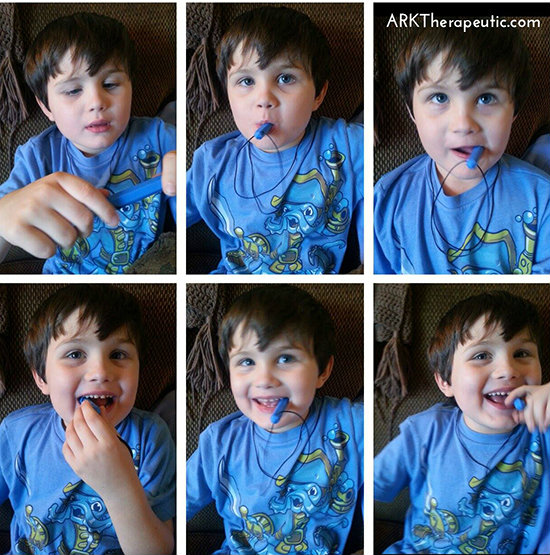
.
.
3. GET TO THE BOTTOM OF WHY
One of the best things you can do is figure out WHY they’re chewing. From there you may be able to help alleviate the core issue(s). For a list of some of the most common reasons, click here.
Study when and how they chew. Keep a journal to see if any patterns or triggers become clear (perhaps they chew the most when they’re bored, tired, upset, frustrated, etc.).
If stress is a main factor, for instance, try your best to limit stressful situations. When stressful situations are unavoidable, try providing them with ways to better manage it, like these ideas for the school setting.
Keep in mind that even if stress/anxiety is not the primary cause, typically kids will chew more during / in response to stressful situations. Also, what you find stressful may not be the same as what they find stressful. Individuals with sensory needs can experience the world differently. A noise you may not even notice, for example, might sound like nails on a chalkboard for someone with auditory sensitivities.
Consult with professionals to identify or rule out any medical causes. The child's pediatrician and dentist are usually two easy places to start. You may also want to consult with a nutritionist, speech therapist, occupational therapist, behavioral psychologist, and/or teachers, etc.
.
.
4. FOLLOW A SENSORY DIET
When the need to chew is sensory-related, consulting with an occupational therapist (OT) is so important that it bears another mention. Among other things, an OT will typically put together what’s called a “sensory diet” to help regulate the child's sensory system. This program may include some of the tips from this post, and/or other strategies as needed. The goal of a sensory diet is to make sure the child is getting the right amount of proprioceptive input throughout the day. Along with many other benefits, this can help decrease the need to chew.
.
.
5. DO GUM MASSAGE
Gum massage can sometimes help decrease the need to chew by providing oral input in a different way. It’s a very simple yet often very effective activity you can do anywhere. For a video demonstration and more information, click here.
You can provide deep input to cheeks/jaw externally to see if that helps, too. If the child won’t allow gum massage inside the mouth, try starting over the cheeks along the gum line at first.
.
.
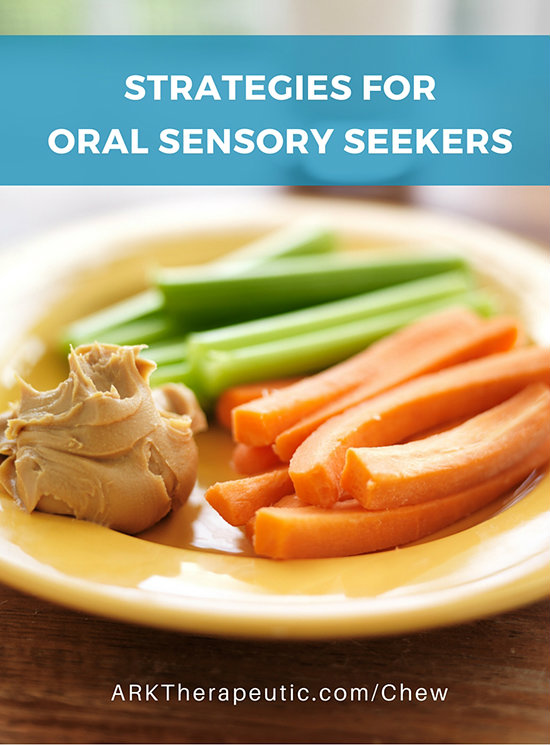
.
.
6. ADD HARDER-TO-CHEW FOODS TO THE DIET
Try adding harder foods to the child's diet (carrots, crackers, apples, etc.) during meals and snack times. Along the same lines as gum massage, this can help provide added input to the jaw. Chewy foods may work, too, as they provide more resistance and make the jaw really work. Sometimes spicy foods and/or foods with strong, intense flavors can help, too. As always, be aware of any allergies, the child's oral motor skills, and/or any other food restrictions.
.
7. INCORPORATE OTHER ORAL ACTIVITIES INTO THE DAILY ROUTINE
Have the child blow through whistles, drink through straws, blow cotton balls across the table, etc. Put bubble mixture in some water and have them blow bubbles with a Bubble Straw. And so forth.
Use curvy bendy twisting straws to make it harder to suck. Drinking thickened liquids through the straw (like applesauce, milkshakes, yogurt, etc.) can also increase the resistance and make the mouth work harder.
Have them bite down on their chew tool and hold for several seconds. And/or gently tug on the chew tool while they hold it in place between their teeth.
Not only do these activities keep the mouth busy, but they also provide oral sensory feedback.
.
.

.
.
8. USE VIBRATION
Try using a vibrating toothbrush for another kind of oral sensory input. Most kids who need to chew are sensory seekers, so they’ll likely love the increased sensation. You can also try using a Z-Vibe or Z-Grabber (vibrating oral motor tools) throughout the day - tap, stroke, and apply gentle pressure to all areas of the mouth, including the lips, gums, tongue, and cheeks. Some kids who need to chew have low oral awareness, in which case this vibration may help "wake up" the mouth with a new, heightened level of sensory stimulation.
.
9. GET ACTIVE WITH HEAVY WORK ACTIVITIES
Oftentimes when there are sensory needs in the mouth, there are sensory needs outside of the mouth, too. When you meet those needs outside of the mouth (when the body gets the right amount of proprioceptive input), the need to chew often decreases. “Heavy work” might sound intimidating, but for the most part this is just about getting active with resistive activities that push or pull against the body - things like swimming, hanging on monkey bars, etc. For more information on heavy work ideas and the benefits, click here.
.
10. KNOW YOU ARE NOT ALONE
I recently spoke with someone whose son has Sensory Processing Disorder (SPD). Although he's now an adult and his sensory needs have mostly subsided, among other things he had a strong need to chew when he was younger, sometimes chewing through several shirts a day. His parents had no idea what was going on or how to help their son.
This was over 25 years ago without the Internet, and back when SPD was a lot less common (or at least people - even doctors - didn’t know about it as much). Yet even today we still hear parents say "I had no idea other families are going through this, too! It's comforting just to know we're not the only ones."
So please take comfort in knowing that you are not alone here. Click here to read first-hand experiences from other parents, and feel free to join our community on Facebook as well.
.
To that same end, please help us spread awareness by sharing this post, especially with anyone who may find it useful.
.
I wish you all the very best!
Debbie
Debra C. Lowsky, MS, CCC-SLP
.






